Qin Y. Micromanufacturing Engineering and Technology
Подождите немного. Документ загружается.

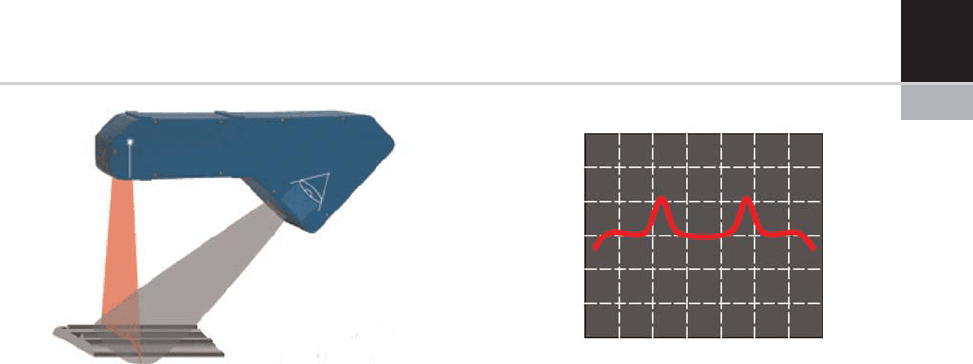
(sub-pixeling) that adopt high resolution CCD
linear or matrix sensor arrays. High resolution
(below 1 mm) bi-dimensional and stereoscopic
image analysis can be carried out by 2D arrays
of sizes greater than 20 megapixels or by linear
arrays of sizes greater than 300 pixels mm. As
with laser beam profilers, a continuous and very
accurate movement of the analyzed part, or the
linear array, has to be considered.
Vibration Measurement and Analysis
Vibration analysis is a very wide and complex
domain which exploits several aspects of the test-
ing and diagnosis disciplines, from condition
monitoring to defect detection. Improvements in
sensor technol ogy now permit the use of vibration
analysis methodology within the micro-/meso-
world also. Non-contact high speed (wide band-
width) laser sensors (typically displacement sen-
sors) can overcome the traditional limits exhibited
by accelerometers, so highly accurate and local-
ized analyses can be performed.
Vibration analysis methodology could be sub-
divided into four principal domains:
*
Time domain
*
Frequency domain
*
Joint domain (time/frequency domain)
*
Modal analysis.
Each domain provides specific information on
the working conditions and features of the vibrat-
ing part.
Typically, time-domain analysis is devoted to
detecting the integral performance of the tested
part: peak, average, root-mean-square (rms),
envelope values of vibration amplitude. These
values are compared with threshold values in
order to detect abnormal performance or latent
defects.
Frequency domain is able to provide more
information as the measured signal is decomposed
into a sequence of frequency components (spec-
trum) by a Fourier transform calculation (or fast
Fourier transform – FFT). Local analysis of the
different frequency components permits the asso-
ciation of a signature with the processed signal,
such that the tested part can be identified precisely
by its own signature (signature analysis). Due to
the time-varying property of the signal, calculating
many spectrums on the time observation window
can be found to be useful. To do so, a joint time/
frequency technique (GaborWignerWavelet)
can be used very efficiently. In a particular case
of time/frequency analysis, the spectrums are
related to the rotational speed of the tested devices
(order analysis), such that the analysis of the single
order which is represented by a frequency compo-
nent varying with the speed is rendered possible.
Modal analysis permits the study of the
dynamic properties of structure s under vibration
excitation. This technique uses FFT in order to
carry out a transfer function which shows one or
more resonances, by means of which it is possible
to estimate the characteristic mass, damping, stiff-
ness and other properties of the tested part. Using
a laser interferometer, and suitable software tools,
it is possible to apply non-contact vibration anal-
ysis for the test and measurement of MEMS
FIGURE 22-14 A profile measurement system using laser and CCD devices.
CHAPTER 22 Testing and Diagnosis for Micro-Manufacturing Systems 351
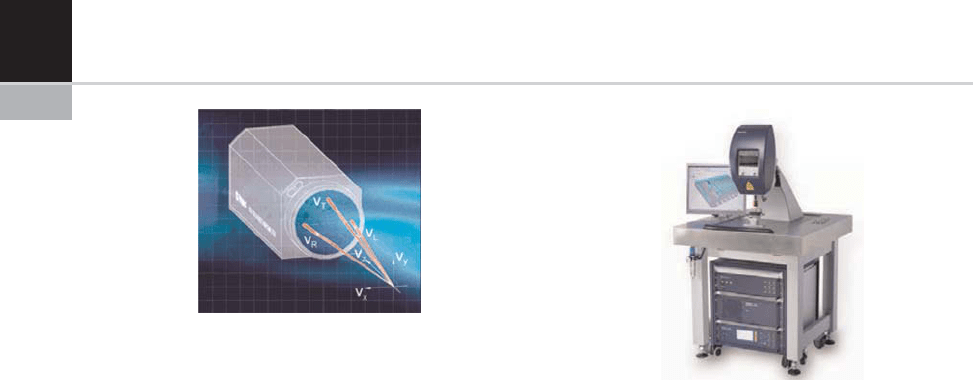
(micro electro mechanical system) and MOEMS
(micro optical electro mechanical system) dynam-
ics and topography.
Mixed QualitativeQuantitative
Analysis Systems
Surface-texture Analysis. This is a typical
application of image analysis techniques wher eby
properties, or features, of analyzed surfaces are
compared with known properties belonging to a
sample image. Due to its mainly qualitative
aspect, surface-texture analysis could be consid-
ered more properly as an inspection methodology;
however, its output may provide information on
both processes and good working conditions of
machines (typically in machining or assembly
areas) and may provide quantitative evaluations
through proper morphological analyses on shapes
and forms.
Principally, the features extraction is per-
formed by a joint domai n (spatial-frequency)
transformation (Gabor, Wavelet) [3] and the fea-
tures comparison is performed by a suitable sta-
tistical classifier: for example, the Mahalanobis
distance, which is scale invariant with respect to
the Euclidean distance (minimum distance classi-
fiers), or maximum likelihood classifiers of which
the Mahalanobis distance is a particular case. A
more complex classifier tool is represented by the
neural network.
A neural network (typically of the back-prop-
agation type) is able to activate particular output
ports when a set of input signals determines the
satisfaction of con ditions for which the network
was previously trained. Independently of the clas-
sifier used and the analysis methodology, image
acquisition is the more critical aspect that involves
both the optical system and the illumination tech-
nique. In the testing of micro-parts, the additional
use of a microscope and coherent light paths is a
primary requirement. Quantitative aspects and
morphological analyses are performed mainly in
the spatial domain.
SEM, AFM and STM. Scanning electron micros-
copy (SEM), atomic force microscopy (AFM) and
scanning tunneling microscopy (STM) are all
widely used surface analysis techniques capable
of very high accura cies (in the range from 10
9
to 10
7
m [4]).
In SEM, the primary electrons hit a surface
with an energy of 0.5–30 keV, and generate many
low energy secondary electrons. The intensity of
these secondary electrons is affected by the surface
topography of the target. An image of the target
surface can then be constructed by measuring the
secondary electron intensity as a function of the
position of the scanning primary electron beam.
AFM systems detect the z-displacement of a
cantilever by the reflection of a laser beam focused
onto the top surface of the cantilever. The feed-
back from this sensor maintains the probe at a
constant force. STM systems meas ure the quan-
tum tunneling current between a wire or a metal-
coated silicon tip and the object surface. An
FIGURE 22-15 3D laser vibrometer by Polytec. The sys-
tem is capable of detecting speed components with a res-
olution of 0.2 mm/s using a laser spot of 65 mm.
FIGURE 22-16 The Polytec MSA-400 Micro System Ana-
lyzer: by scanning laser-doppler vibrometry it is capable of
performing the precise 3D dynamic characterization of
MEMS and MOEMS micro-structures.
352 CHAPTER 22 Testing and Diagnosis for Micro-Manufacturing Systems
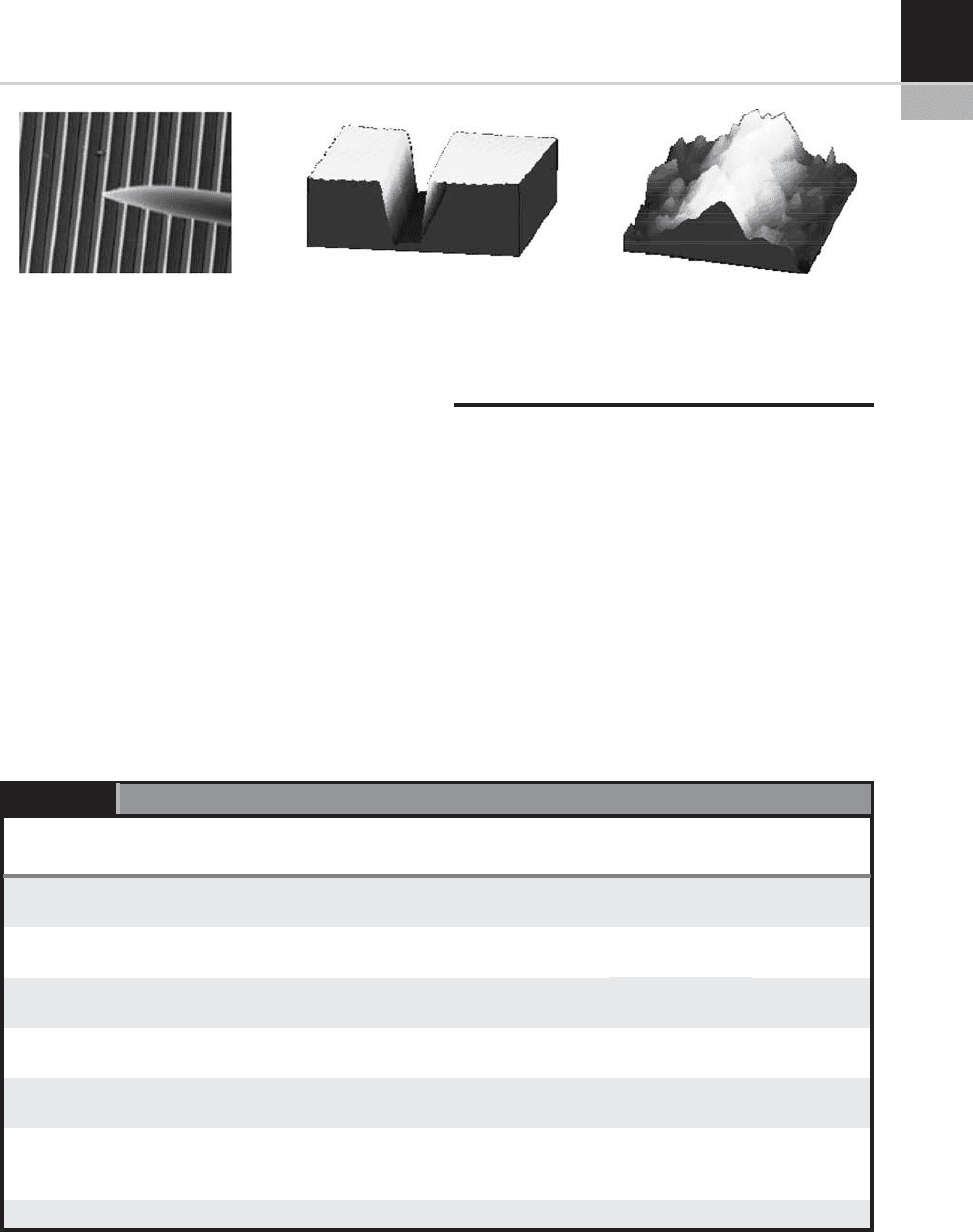
electronic feedba ck system maintains a constant
current by positioning the tip to just make contact
with the surface.
SEM is often used to survey surface-analysis
problems before proceeding to techniques that
are more surface sensitive and more specialized,
such as AFM or STM. High resolution images of
surface topography, with excellent depth of field,
are produced using a highly focused SEM. These
kinds of SEM are also able to provide high spatial
resolution, except when the target consists of very
narrow and deep wells. This is the case, for exam-
ple, of a trench in a semiconductor wafer in which
an SEM cannot view the bottom or the sidewall of
the trench structure. In these cases the combina-
tion of SEM and AFM (or STM) an alysis has to be
considered.
TESTING AND DIAGNOSIS
METHODS
As mentioned earlier in the introduction, testing
and diagnosis for micro-manufacturing products/
machines may now take advantage of new
approaches in measurement and control system
methodologies. Contactless sensors systems and
model-based measurem ent systems are two exam-
ples of such approaches. Both methodologies aim
to minimize interaction between the measurement
system and the tested workpiece, in order to:
*
save space for sensor allocation;
*
retrieve more information from the observed
system.
Another advantage is that, in the model-based
measurement systems, the number of sensors is
TABLE 22-1
Performance of Measurement Systems
Measurement Measurement
Technique
Size of Parts
(mm)
Accuracy (mm) Measurement
Time (ms)
Online
Analysis
Dimensional
measurement
1D, 2D, 3D Laser
interferometer
>0.01 0.01 >1 Yes
1D Laser
triangulation
>0.1 0.1 >10 Yes
Thickness
measurement
Laser barrier >0.001 0.1 >10 Yes
Profile and shape
measurement
Laser-Optics >0.01 0.1 >10 Yes
Vibration
measurement
Laser
interferometer
>0.1 0.1 >10 Yes
Surface texture and
profile
measurement
Optics/Laser >0.1 1 >100 Yes
SEM, AFM, STM >0.01 0.001 >100 No
FIGURE 22-17 SEM image of a Nanonics AFM Probe in contact with sample. 10 10 micron AFM image of a 10 micron
deep/2 micron wide trench and a 1 1 micron AFM image of the bottom of the deep trench.
CHAPTER 22 Testing and Diagnosis for Micro-Manufacturing Systems 353

minimized. This characteristic is an important
requirement because the sensors are fault sensi-
tive, and critically increase the production costs of
the systems.
Basic foundations of testing and diagnosis rest
upon fault detection and isolation techniques
(FDI) and can be based on qualitative, quantita-
tive or history-based information/data with the
use of modeling techniques. These methods per-
mit process adjustment and tuning in order to
achieve optimal performance and to ensure prod-
uct quality assurance approaches [5]. The term
‘fault’ is genera lly defined as ‘a departure from
an acceptable range of an observed variable or a
calculated parameter associated with a proces s’.
This defi nes a fault as a process abnorma lity or
symptom, such as a high vibration level in a
machine or a high pos itional error in a controll ed
device. The underlying cause of this abnormality,
such as a failed ball bearing, or a defective con-
troller, is called the basic event or the root cause.
Note that there are several main ch aracteristics
that a testing/diagnostic system has to satisfy and
that these will not usually be met by any single
diagnostic method. Therefore, it may be useful to
benchmark various methods in terms of the a
priori information that needs to be provided, the
reliability of the solution, and the generality and
efficiency in computation. Table 22- 2 sum-
marizes the main requirements of a generalized
diagnostic system.
Diagnostic systems can be classified according
to the a priori knowledge used (Fig. 22-18). The
basic a priori knowledge that is needed for fault
diagnosis is the set of failures an d the relationship
between the observations (symptoms) and the
TABLE 22-2
Main Characteristics of a Testing/Diagnostic System
Quick detection and
diagnosis
The diagnostic system should respond quickly in detecting and diagnosing process
malfunctions. These characteristics are related to the bandwidth of the diagnostic system.
Isolability It is the ability of the diagnostic system to distinguish between different failures.
Robustness Rejection to various noise and uncertainties.
Novelty identifiability The diagnostic system is able to decide, given current process conditions, whether the
process is functioning normally or abnormally, and, if abnormal, whether the cause is a
known malfunction or an unknown, novel, malfunction.
Classification error estimate An important practical requirement for a diagnostic system is in building the user’ s
confidence on its reliability. This could be greatly facilitated if the diagnostic system could
provide a priori estimates of classification errors that can occur.
Adaptability Processes in general change and evolve due to changes in external inputs or structural
changes due to retrofitting and so on. Process operating conditions can change not only due
to disturbances but also due to changing environmental conditions. Thus the diagnostic
system should be adaptable to changes.
Explanation facility Besides the ability to identify the source of malfunction, a diagnostic system should also
provide explanations of how the fault originated and propagated to the current situation.
Modeling requirements Modeling is any a priori knowledge about the system to be observed. For fast and easy
deployment of a real-time diagnostic system, the modeling effort should be minimal.
Storage and computational
requirements
Usually, quick real-time solutions would require algorithms and implementations which are
computationally less complex, but might entail high storage requirements. One would prefer
a diagnostic system that is able to achieve a reasonable balance of these two competing
requirements.
Multiple fault identifiability The ability to identify multiple faults. In a general non-linear system, the interactions would
usually be synergistic and, hence, a diagnostic system may not be able to use the individual
fault patterns to model the combined effect of the faults.
354
CHAPTER 22 Testing and Diagnosis for Micro-Manufacturing Systems
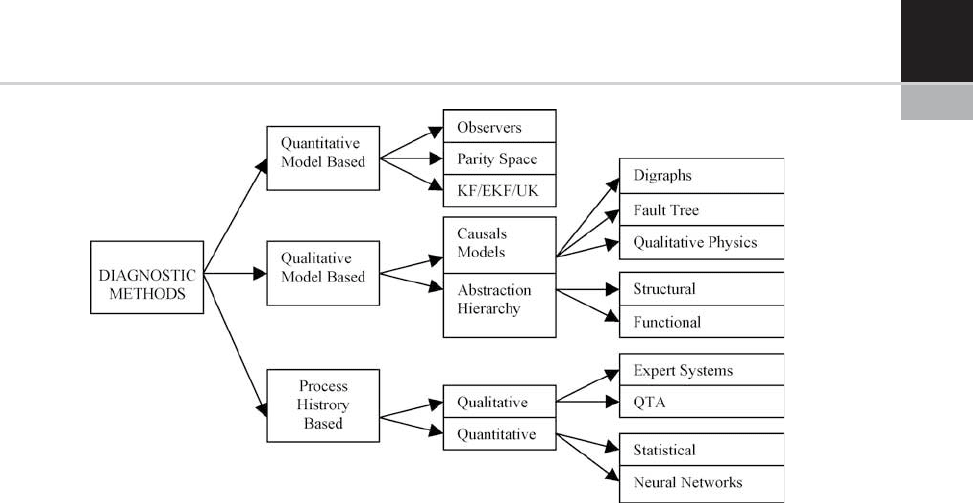
failures. The relationship between obs ervations
and failures could be explicit (as in a look-up
table), or it may be inferred from some source of
knowledge. In particular such knowledge is
referred to as causal or model-based knowledge.
On the other hand, it may be gleaned from past
experience with the process. This knowledge is
referred to as process history-based knowledge.
The model-based knowledge can be broadly clas-
sified as qua litative or quantitative. The model is
usually developed based upon some fundamental
understanding of the physics of the process. In
quantitative models this understanding is
expressed in terms of mathematical functional
relationships between the inputs and outputs of
the system. In contrast, in qualitative model equa-
tions these relationships are expressed in terms of
qualitative functions centered around different
units in a process.
Process history-based methods differ from the
model-based approaches, where a pr iori knowl-
edge about the model of the process is assumed
(either quantitative or qualitative), in that only
the availability of large amounts of historical pro-
cess data is assumed.
The remainder of this chapter will focus on
diagnostic methods based on a quantitative
approach.
Quantitative Model-based Testing
In model-based methodology the feature space is
characterized by the use of suitable analytical
techniques which permit the achievement of fea-
tures starting from meas urements (observed sig-
nals), mathematical or experimental models of
the observed system, some statistical information
about model uncertainties and signal noise. Some
of the most suitable techniques are:
*
Adaptive observers;
*
Parity relations;
*
Kalman filters (KF); and
*
Parameters estimation algorithms.
The performances of various methods are sum-
marized in Table 22-3, with reference to feature
extraction capability, non-linear systems handling,
noise rejection and the possibility to estimate not
only state, but also parameter deviations. In
particular, extended (EKF) and unscented (UKF)
formulations are very efficient and can be imple-
mented with a low/medium level of computation
complexity. These will be described in the follow-
ing paragraph as state estimators.
A state estimator permits the extraction of a
greater number of features than the observed sig-
nals, for example: by measuring the position of a
slide, driven by a linear motor, and the currents in
FIGURE 22-18 Classification of diagnostic techniques.
CHAPTER 22 Testing and Diagnosis for Micro-Manufacturing Systems 355
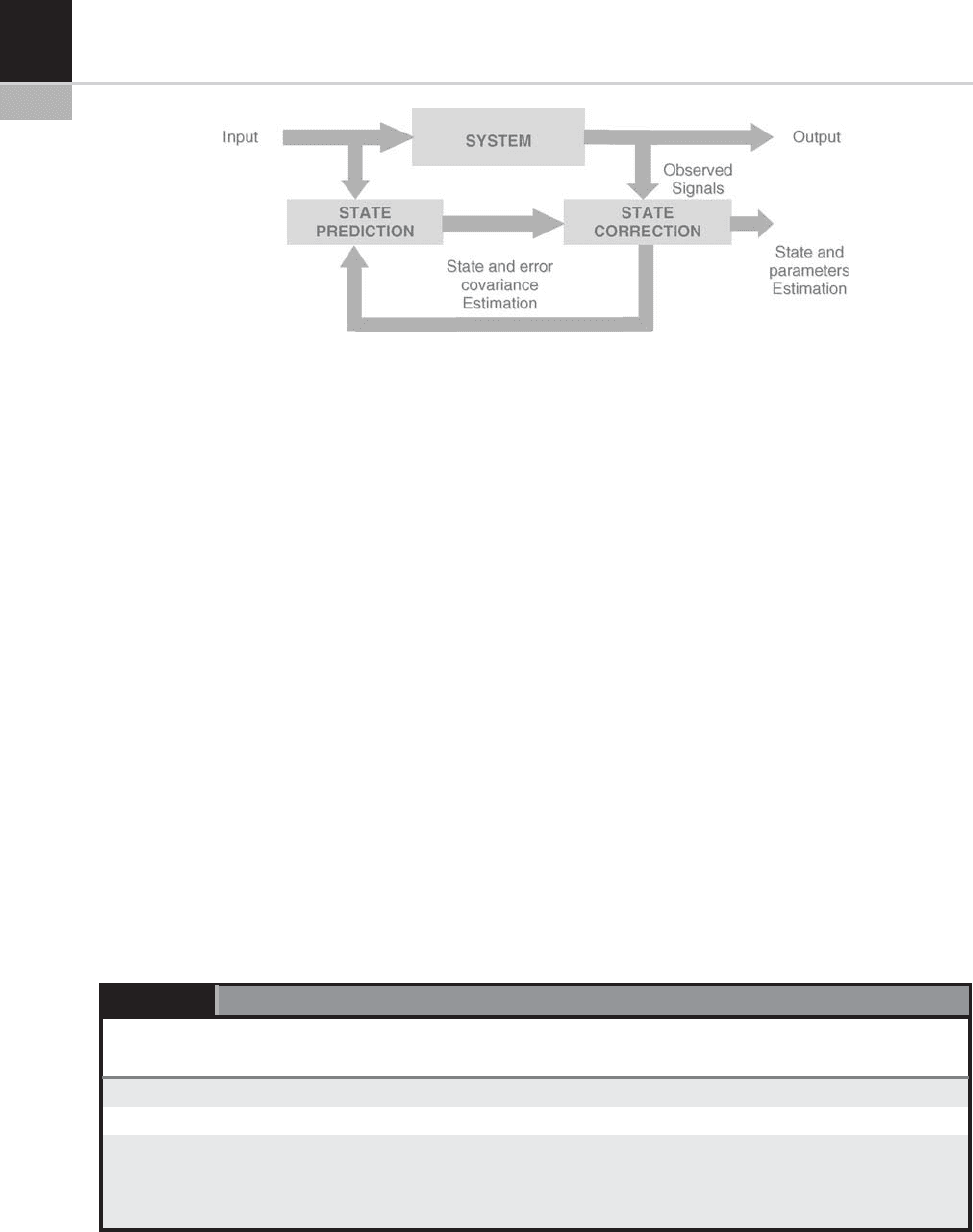
the motor coils, it is possible to estim ate velocity,
force, friction, stiffness and other system para-
meters. Of course it is necessary to exploit a model
of the system to be observed and this task can be
carried out by the use of suitable simulation soft-
ware. The advantages of using state estimators for
testing application in the micro-manufacturing
area are clear; in fact, in order to enhance both
the fault detection and classification sensibility it
is possible to minimize the number of sensors by
increasing the estimated features.
Figure 22-19 illustrates a typical Kalman state-
estimator representation.
This approach, thanks to knowledge of the
model, allows both the observed signals (as part
of the output system) and input to be used to
produce a prediction of the current state of the
observed system. The prediction is then used to
correct the current state in order to produce an
estimation of the next system state by a recursive
cycle. If the system model, which represents the
knowledge, includes both variables and para-
meters of interest (features), then these will be
used as fai lure detectors when the deviation
(residual) referred to the nominal value is greater
than a pre-fixed threshold.
The generation of residuals is a recursive and
online procedure capable of control ling the beha-
viors of the system and can even provide a forecast
of possible faults (detection) and their classifica-
tion.
Differently from diagnos tic procedures, those
of testing can involve test-pattern generation for
the inputs to the system to be tested. Therefore,
achieving optimal performance of the testing sys-
tem will require both a suitable choice for the
system model (the estimation of the most suitable
variables and parameters) and the best selection of
test-pattern input for target faults.
The major advantage of using the quantitative
model-based approach is that full control over the
behavior of the system will be attained. The math-
ematical relationships give an analytical redun-
dancy that is useful for relating the internal
state variation to the measurements. As the states
can be associated to the particular physical
FIGURE 22-19 Standard Kalman state-estimator representation.
TABLE 22-3
Performance Comparison of the Main Quantitative Model-based Estimators
Features Greater than
Measurements
Non-linear
System
Disturbance
Rejection
Parameters
Estimation
Parity space NO YES POOR NO
Observers YES YES GOOD YES
Kalman filters:
LKF (linear)
EKF (extended)
UKF (unscented)
YES
YES
YES
NO
YES(CRITICAL)
YES
HIGH
HIGH
HIGH
NO
YES
YES
356
CHAPTER 22 Testing and Diagnosis for Micro-Manufacturing Systems

characteristics of components inside the system, a
fault can be detected rapidly by the abnormal
change of states and incorrect component identi-
fied.
The main problems associated with the model-
based diagnosis methods refer to the complexity
of the syst em, high dimensionality and pro cess
non-linearity. Such problems often result in diffi-
culties in developing accurate mathematical mod-
els of the system. Another problem in these
approaches is the simplistic approximation of
the disturbances that include modeling errors. In
most cases, the disturbance includes only additive
uncertainty. However, in practice, it may be
advisable to proceed as follows, where appropri-
ate:
1. Begin with a simple model, stating the
assumptions in order to focus on particular
aspects of the phenomenon.
2. Identify important variab les and constants
and determine how they relate to each other.
3. Develop the equations that express the rela-
tionships between the variables and constants.
Mathematical models typically contain three
distinct types of quantities: input variables,
dynamic state output variables, and parameters.
Output variable s give the model solution. When
parameters depend on environment interaction
then the choice of what to specify as input vari-
ables and what to specify as parameters is some-
what arbitrar y and, often, model dependent.
Input variables may raise severe modeling uncer-
tainties in the form of mul tiplicative uncertainties.
Another disadvantage with these methods is that,
if a fault is not specifically modeled (novelty iden-
tifiability), there is no certainty that the residuals
will be able to detect it.
When a large-scale process is considered, the
size of the bank of filters may seriously increase
the computational complexity, although, with the
recent increase in computational power and the
essential linear nature of these problems, this may
no longer be a serious bottleneck.
The core of a qua ntitative model-based testing
procedure is the state estimator. The important
issue in the estimators is the knowledge of the
system model. Building a mathematic al model
for a system can be a difficult, yet interesting, task:
it is essential to know all the features of the pro-
cess and, there fore, a thorough understanding of
the underlying scientific concepts is necessary.
Although problems may require very different
methods of solution, the following steps outline
a general approach to the mathematical modeling
process [6]:
1. Identify the problem, define the terms, and
draw diagrams which characterize a single
physical problem while the parameters deter-
mine the context or setting of the physical
problem. Dynamic systems are also character-
ized by a set of variables called states that
represent the memory of the system. A typical
representation in state variables is:
dxðtÞ
dt
¼ fðt; xð tÞ; uðtÞ; uðtÞÞ ð1Þ
yðtÞ¼hðt; xðtÞ; uðtÞÞ ð2Þ
where x are the states, u the inputs, y the out-
puts and u the parameters.
2. The simplest case is when the system is time
invariant and is modeled with linear differen-
tial equations:
dxðtÞ
dt
¼ F
xðtÞþGuðtÞ yðtÞ¼HxðtÞþLuðtÞð3Þ
3. The equations are typically continuous, but
for computer processing purposes they are
expressed in discrete time:
x
kþ1
¼ Ax
k
þ Bu
k
y
k
¼ Cx
k
þ Du
k
ð4Þ
The problem of a state estimator is to measure
the output y and, by knowledge of input u and the
matrices of the model A, B, C, D, to extra ct the
state x.
During the design and analysis of technical
systems that encompass several physical domains,
the use of adequate models is of great importance.
Using suitable techniques of modeling and simu-
lation, these models are easy to create and can be
CHAPTER 22 Testing and Diagnosis for Micro-Manufacturing Systems 357
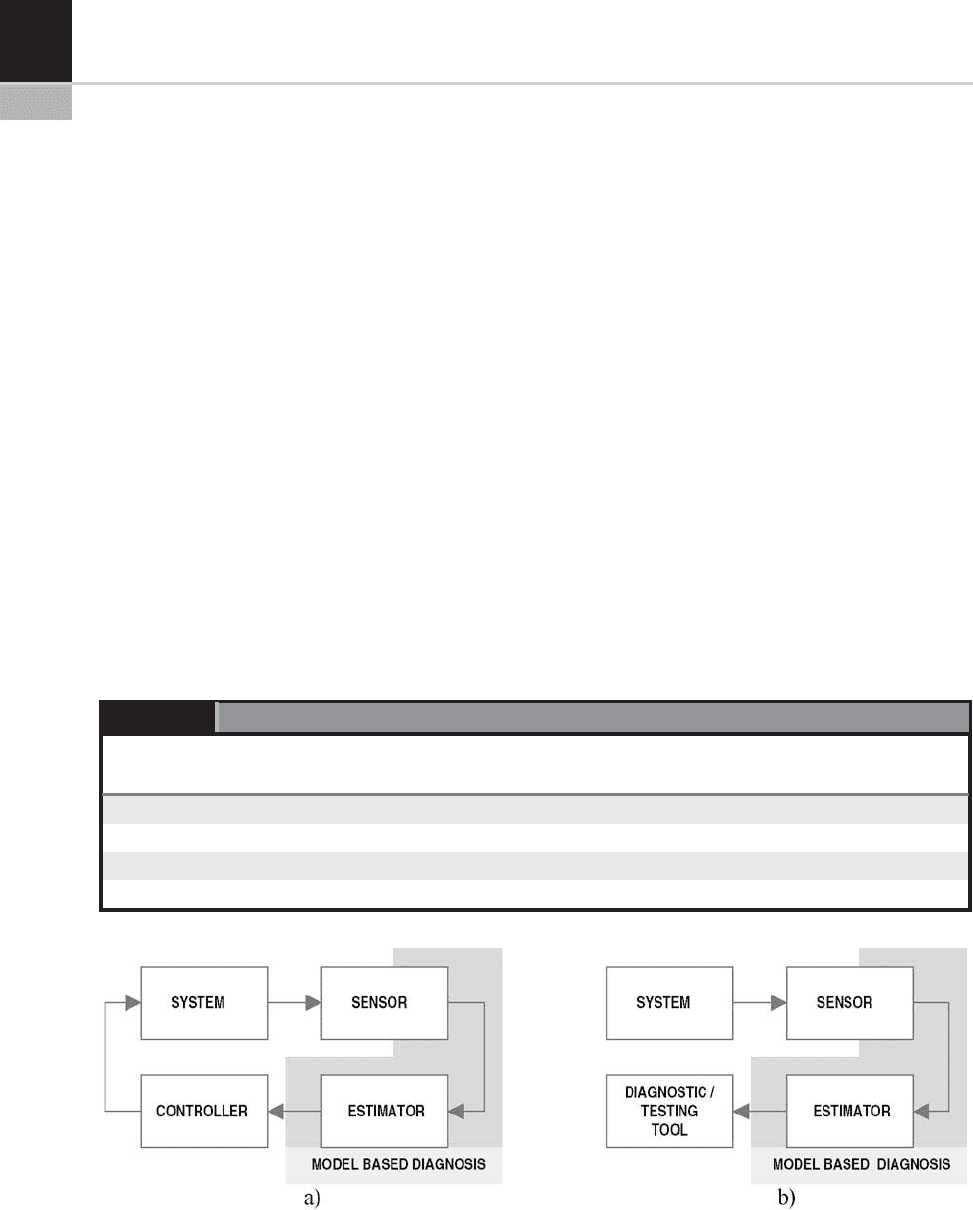
updated rapidly when this is required. Gene rally,
an important aspect of systems is their dynamic
behavior. Thi s is especially true for systems that
exhibit fast changes or systems that should behave
accurately: in such cases it is useful to choose the
most appropriate model that meets the achieve-
ment of performance and then simulate to update
the best parameter values.
In micro-engineering, the characterization of
materials, micro-structures and properties is fre-
quently carried out through simulations. This is
often done to better understand and reproduce
mechanical behavior. During the development of
a new micro-device, math ematical equations gov-
erning the physics of the process are known. Due
to this feature, model-based techniques for fault
diagnosis or testing can be applied in this field. In
fact, a reduced number of sensors are often
required for systems having reduced dimensions.
The state-estimator method can easily reduce the
number of sensors because there is an analytical
redundancy introduced by the mathematical rela-
tionship. In this manner some sensors can be omit-
ted because the measurements are estimated.
Some techniques, such as the Kalman filters, are
also useful because they produce reliable esti-
mates from noisy measurements. This permits
the reduction of the scale of the application with-
out serious problems.
Together, the state and parameter estimations
are useful to follow the performance alterations of
internal components of a complex system. If the
characteristics of a component vary slowly, and
the maximum allowed displacement is known,
then the time at which a substitution will be nec-
essary may be calculated. Thi s is the core of pre-
dictive diagnosis. With parameter estimation, the
changes in some machine parameter (for example,
the friction) may be estimated, such that the coef-
ficients of a software controller may be rapidly
reconfigured. This is an auto-compensation tech-
nique which leads to auto-repairing strategies.
All these features of the model-based diagnosis
methods meet the most important requirements
of a micro-application system, as evidenced in
Table 22-4.
TABLE 22-4
How Model-based Diagnosis meets the Requirements of a Micro-application
Sensors Reduction Predictive
Diagnosis
Disturbance
Rejection
Auto Repairing
Space saving X
High efficiency XXXX
High reliability XXXX
Low cost X X
FIGURE 22-20 Architectures of model-based diagnosis: (a) controlled systems; (b) diagnostic systems.
358 CHAPTER 22 Testing and Diagnosis for Micro-Manufacturing Systems
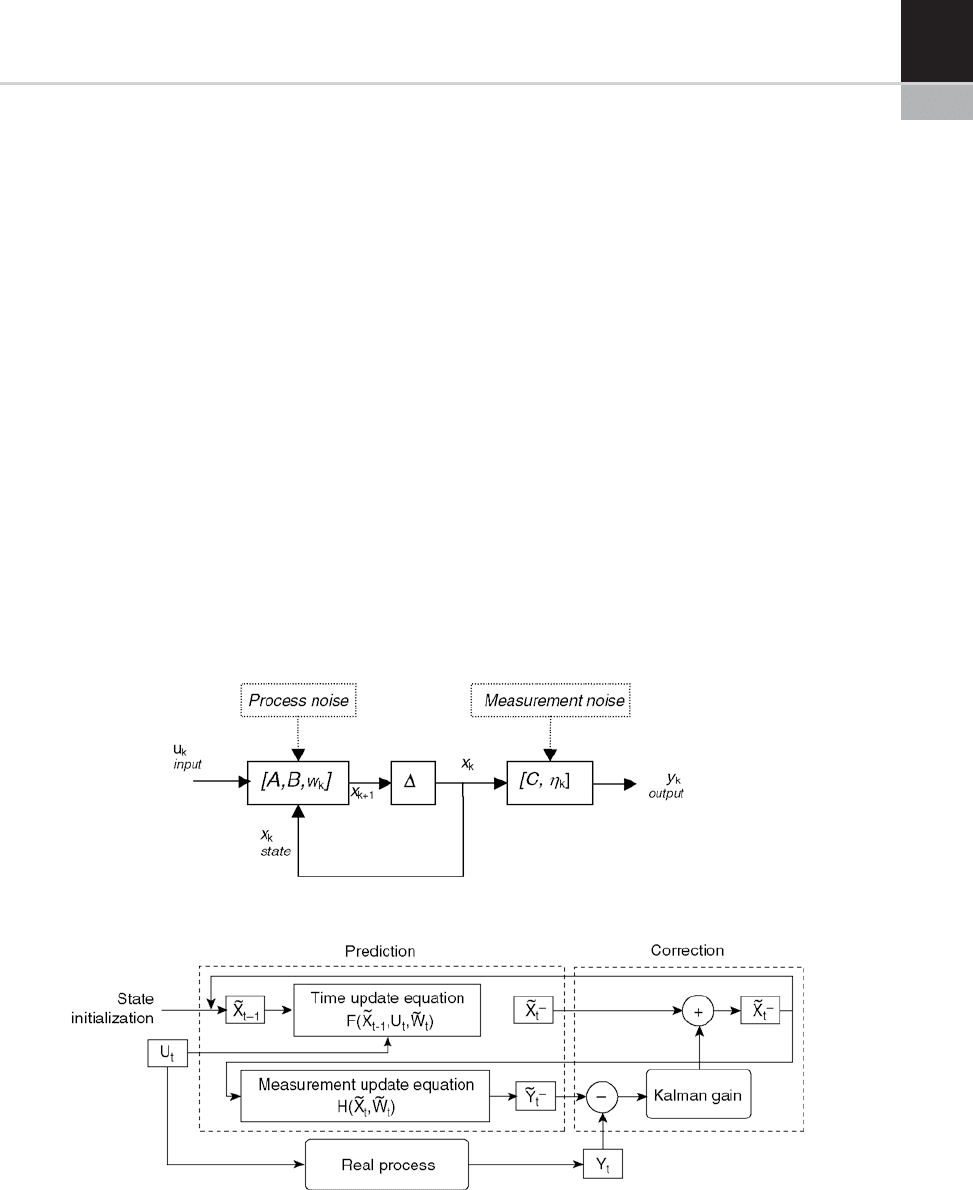
The Kalman Estimator
The Kalman estimator, or Kalman filter (KF), is a
mathematical algorithm that provides efficient
computational and recursive methods to estimate
the state of a process by minimizing the variance
of the estimate error. The filter is very powerful in
several aspects: it supports estimations of past,
present, and even future states, and it can do so
even when the precise nature of the modeled sys-
tem is unknown [7,8].
The basic framework for the discrete KF
involves the estimation of the state of the dynamic
system: this can be a discrete time-linear or a non-
linear system represented in state variables. The
dynamic system behavior is assumed as a well-
known model with Eqns (4) modified in order to
take into account model inaccuracy w
k
and mea-
surement noise h
k
:
x
kþ1
¼ Ax
k
þ Bu
k
þ w
k
y
kþ1
¼ Cx
kþ1
þ h
k
ð5Þ
The KF estimates a process by using a feedback
concept: the filter estimates the state at a given
time and then obtains feedback in the form of
innovations or residuals.
The equations for the KF fall into two groups:
time update equations and measurement update
equations. In order to obtain the a priori estimates
for the next time step, the time upda te equations
are responsible for projecting forward (in time)
the current state and error covariance estimates.
The measurement update equations are responsi-
ble for the feedback; i.e. for incorporating a new
measurement into the a priori estimate to obtain
an improved a posteriori estimate.
The time update equations can also be thought
of as predictor equations, while the measurement-
update equations can be thought of as corrector
equations: the time update projects the current-
state estimate forward in time. The measurement
update adjusts the projected estimate by an actual
measurement at that time. The final estimation
algorithm resembles that of a predictor-corrector
algorithm for solving numerical problems [9].
FIGURE 22-21 General ‘prediction-correction’ structure of the Kalman filter. Model parameters are assumed to be
known.
(5)
CHAPTER 22 Testing and Diagnosis for Micro-Manufacturing Systems 359

The Kalman filter, also called the LKF (linear
Kalman filter), is only used for linear systems;
unfortunately, many real-world systems, espe-
cially mechanical systems, are non-linear in
nature. Since even the measurement relationships
to the process are often non-linear, the KF cannot
be used to estimate the states. The extended Kal-
man filter (EKF) was developed to account for
these non-linearities: in order to estimate the state,
even if the system is non-linear, this evolution of
the Kalman filter obtains a linearization around
the current mean and covariance. This filter is
based upon the principle of linearizing the mea-
surements and evolution models using Taylor
series expansions (truncated at the first-order
term, with the assumption that the error incurred
by neglecting the higher-order terms is small in
comparison to the first-order terms). The series
approximations in the EKF algorithm can, how-
ever, lead to poor representations of the non-linear
functions and probability distributions of interest.
It is important to note that a fundamental flaw
of the EKF is that the dist ributions (or densities in
the continuous case) of the various random vari-
ables are no longer normal after undergoing their
respective non-linear transformations. When the
system has strong non-linear transformations,
the EFK may be an inadequate state estimator,
because the system loses its features, especially
for estimation of convergence time.
For heavily non-linear systems, the UKF
(unscented Kalman filter) solves the approxima-
tion issues of the EKF. The state distribution is
represented by a Gaussian random variable
(GRV), using a minimal set of carefully chosen
sample points (called sigma points). These sample
points completely capture the true mean and
covariance of the GRV, and, when propagated
through the true non-linear system, capture the
posterior mean and covariance accurately to the
third order (Taylor series expansion) for any non-
linearity. The unscented Kalman filter is based on
the unscented transform (UT) and does not require
linearization to handle non-linear equations [10].
The UKF leads to more accurate results than
the EKF and, in particular, it genera tes much bet-
ter estimates of the covariance of the states (the
EKF seems to unde restimate this quantity). The
UKF has, however, the limitation that it does not
apply to general non-Gaussian distributions.
The SRUKF (square-root unscented Kalman
filter) is a filter based on UFK and it reduce s the
algorithm complexity by the adequate use of the
Cholesky and QR decompositions.
APPLICATION ON MICRO-DEVICES
AND MACHINES
As an example of how model-based testing can be
applied to the testing of devices particularly suited
for micro-positioning application, the case of pie-
zoelectric inchworm motors may be considered.
These devices take advantage of piezo-ceramic
characteristics to produce displacements with
nanometer resolution, while large travel is assured
by an inchworm technique. The inchworm tech-
nique is based on the simple concept of the incre-
mental sum of the relatively small displacements
produced by piezo-ceramic elements in order to
generate a large displacement.
As shown in Fig. 22-22, a typical inchworm-
type linear motor has three major components:
two clamping mechanisms (referred to as brakes
B1 and B2) and an extendi ng mechanism (referred
as mover M). During the greater part of a typical
inchworm cycle, only one clamping device is to be
activated at any given time, thus allowing the
extender to extend and retract freely. The clamp-
ing mechanisms are normally designed to create a
frictional force that can withstand the static forces
produced by a constant load and dynamic forces
produced by the extending mechanism. The pur-
pose of the extending mechanism is to generate
the small displacements which the inchworm
technique sums to produce a large displacement.
The typical cycle of an inchworm technique
linear motor reveals that the velocity of the motor
is directly dependent on the step size of the motor
and on the rate at which the cycle is repeated. To
determine a model for a designed motor, the
important param eters to be considered all relate
to the behavior of the model [11]. The chosen
parameters are the stiffness and damping of the
extending mechanism, the mass of the clamping
360 CHAPTER 22 Testing and Diagnosis for Micro-Manufacturing Systems
